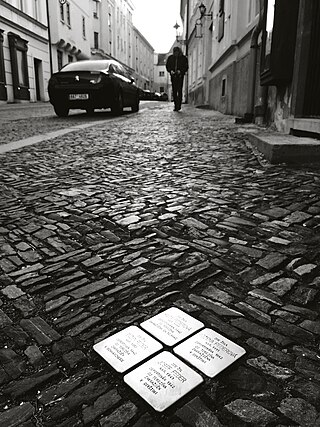
A Stolperstein is a ten-centimetre (3.9 in) concrete cube bearing a brass plate inscribed with the name and life dates of victims of Nazi extermination or persecution. Literally, it means 'stumbling stone' and metaphorically 'stumbling block'.
The history of the Jews in Sicily potentially begins as far back as two millennia, with a substantial Jewish presence on the southern Italian island before their expulsion in the fifteenth century.
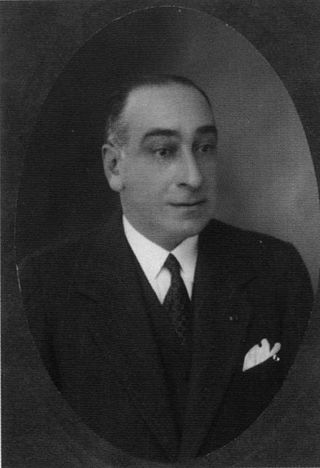
Cavalier Angelo Donati was an Italian banker and philanthropist, and a diplomat of the San Marino Republic in Paris.

The Stolpersteine in Prague-Josefov lists the Stolpersteine in the town quarter Josefov of Prague, the former Jewish quarter of the city. Stolpersteine is the German name for stumbling blocks collocated all over Europe by German artist Gunter Demnig. They remember the fate of the Nazi victims being murdered, deported, exiled or driven to suicide.
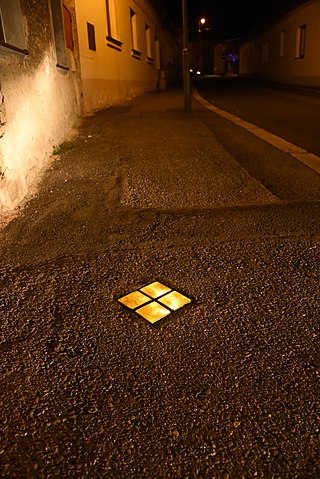
The Stolpersteine in the Plzeň Region lists the Stolpersteine in the Plzeň Region of the Czech Republic. Stolpersteine is the German name for stumbling blocks collocated all over Europe by German artist Gunter Demnig. They remember the fate of the Nazi victims being murdered, deported, exiled or driven to suicide.

The Stolpersteine in the Jihočeský kraj lists the Stolpersteine in the Czech region Jihočeský kraj. Stolpersteine is the German name for stumbling blocks collocated all over Europe by German artist Gunter Demnig. They help us remember the fate of the Nazi victims being murdered, deported, exiled or driven to suicide.

The Stolpersteine in Zlín Region lists the Stolpersteine in the Zlín Region in the central-eastern part of Moravia. Stolpersteine is the German name for stumbling blocks collocated all over Europe by German artist Gunter Demnig. They remember the fate of the Nazi victims being murdered, deported, exiled or driven to suicide.
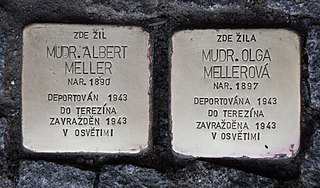
The Stolpersteine in the Pardubický lists the Stolpersteine in the Pardubice Region in the east of Bohemia. Stolpersteine is the German name for stumbling blocks collocated all over Europe by German artist Gunter Demnig. They remember the fate of the Nazi victims being murdered, deported, exiled or driven to suicide.

The Stolpersteine in the Moravskoslezský kraj lists the Stolpersteine in the Moravian-Silesian Region in the easternmost part of Moravia. Stolpersteine is the German name for stumbling blocks collocated all over Europe by German artist Gunter Demnig. They remember the fate of the Nazi victims being murdered, deported, exiled or driven to suicide.
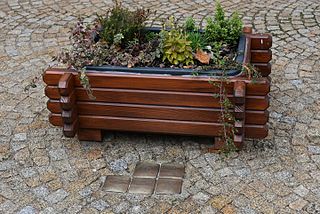
The Stolpersteine in Lomnice u Tišnova lists the Stolpersteine in the town Lomnice in the South Moravian Region. Stolpersteine is the German name for stumbling blocks collocated all over Europe by German artist Gunter Demnig. They remember the fate of the Nazi victims being murdered, deported, exiled or driven to suicide.

The Stolpersteine in Mikulov, Slavkov u Brna and Znojmo lists the Stolpersteine in three towns of the South Moravian Region. Stolpersteine is the German name for stumbling blocks collocated all over Europe by German artist Gunter Demnig. They remember the fate of the Nazi victims being murdered, deported, exiled or driven to suicide.

The Stolpersteine in Mladá Boleslav lists the Stolpersteine in the town of Mladá Boleslav in the Central Bohemian Region in the Czech Republic. Stolpersteine is the German name for stumbling blocks collocated all over Europe by German artist Gunter Demnig. They remember the fate of the Nazi victims being murdered, deported, exiled or driven to suicide.

The list of stolpersteine in Prague-Břevnov, Bubeneč and Dejvice contains the stumbling blocks that were placed in the Prague district of Břevnov and Bubeneč as well as in the cadastral district of Dejvice. Břevnov has partially belonged to Prague since 2002, Dejvice is entirely part of Prague 6. Bubeneč was divided between Prague 6 and Prague 7. The stumbling blocks remind and make aware of the fate of the people who were murdered, deported, expelled or driven into suicide by the national socialists. The Stolpersteine were designed and placed by Gunter Demnig.

Stolpersteine is the German name for small, cobble stone-sized memorials installed all over Europe by German artist Gunter Demnig. They remember the fate of the victims of Nazi Germany being murdered, deported, exiled or driven to suicide. The first Stolperstein in Genoa, the capital of the Italian region of Liguria, was installed in January 2012.

Stolpersteine is the German name for small, cobblestone-sized memorials placed around Europe by the German artist Gunter Demnig. They commemorate the victims of Nazi Germany who were murdered, deported, exiled or driven to suicide. The first Stolpersteine in Milan, the capital of the Italian region of Lombardia, were established in January 2017.

Stolpersteine is the German name for stumbling blocks collocated all over Europe by German artist Gunter Demnig. They remember the fate of the victims of Nazi Germany being murdered, deported, exiled or driven to suicide. The first Stolperstein collocations in the Banskobystrický kraj, the Banská Bystrica Region of present-day Slovakia, took place in Banská Bystrica and in Brezno on 31 October 2012.

The Stolpersteine in Říčany lists the Stolpersteine in the town of Říčany. Stolpersteine is the German name for stumbling blocks collocated all over Europe by German artist, Gunter Demnig. The blocks commemorate the Nazi victims that were murdered, deported, exiled, or driven to suicide.

The Stolpersteine in Loštice lists the Stolpersteine in the town Loštice, Czech Republic. Stolpersteine is the German name for stumbling blocks collocated all over Europe by German artist Gunter Demnig. They remember the fate of the Nazi victims being murdered, deported, exiled or driven to suicide.

The Stolpersteine in Hranice na Moravě lists the Stolpersteine in the town Hranice na Moravě, Czech Republic. Stolpersteine is the German name for stumbling blocks collocated all over Europe by German artist Gunter Demnig. They remember the fate of the Nazi victims being murdered, deported, exiled or driven to suicide.






















